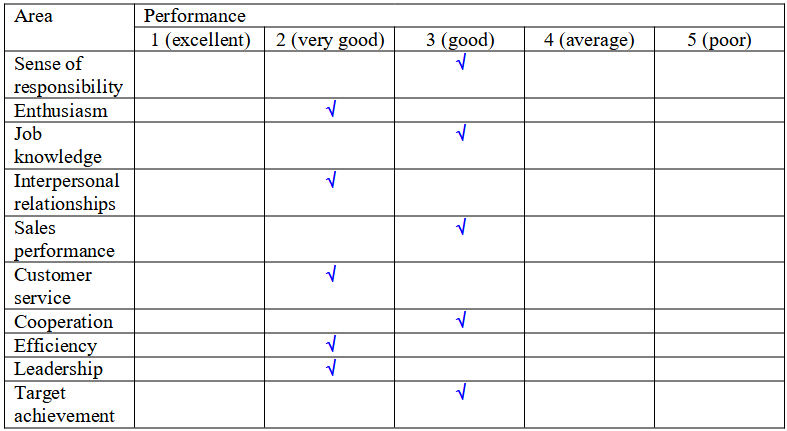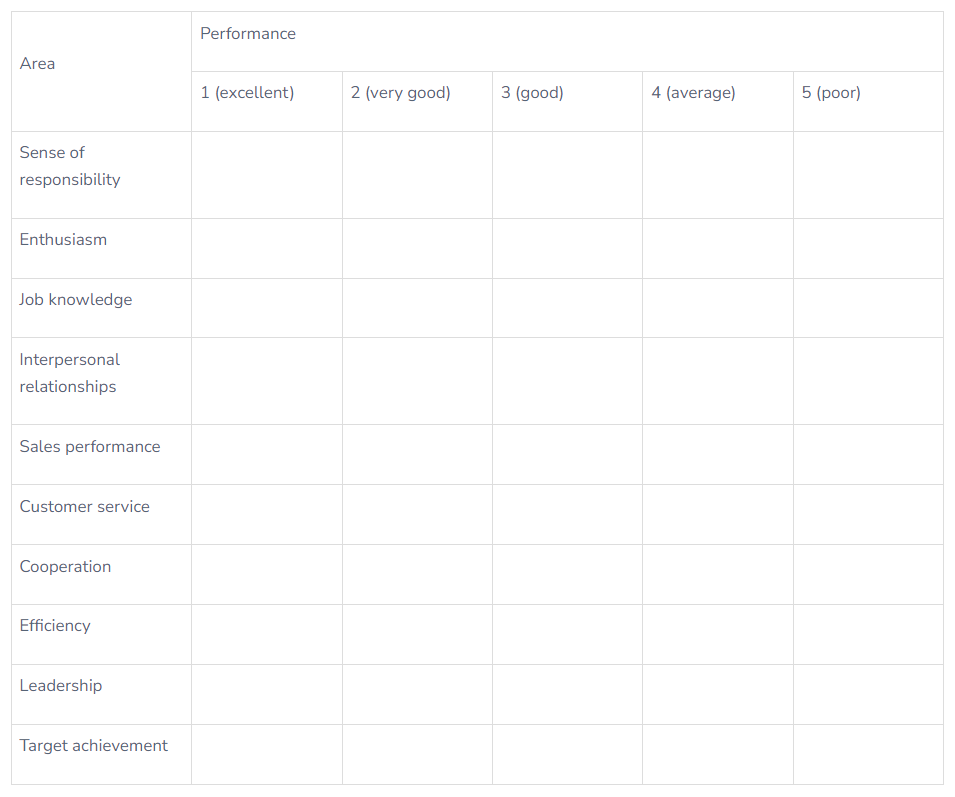Writing at Workplace
Writing an appraisal document

Section A: Definition
An appraisal is an evaluation of an employee’s performance in his/her job. Companies, organizations and institutions use this to judge a worker’s performance in order to decide whether:
- to continue employing him/her
- to promote the staff or not
- to allow opportunities for improvement in those areas where an employee is not fulfilling his/her duties in a very satisfactory way
Section B: Procedure
1. Understand the job requirements
You need to be clearly aware of the expectations of the job requirements first in order to judge whether the employee has successfully fulfilled them.
2. Keep track of the employee’s performance during the appraisal period
You have to pay attention to the staff member under review to notice how he/she has completed his/her duties.
Do you feel satisfied or not?
Are there any parts in which you think need improvement?
Note down relevant information for you to have an objective evaluation with suitable evidence.
3. Fill in the appraisal document
According to the information you have collected above, complete the appraisal document in a fair and objective manner. State clearly where the employee has done well and which areas he/she needs improvement.
4. Interview the employee
Meet the staff and let him/her know your evaluation in order for him/her to be aware of his/her performance. Provide constructive feedback. Give him/her the chance to share his/her point of view after you have given him/her the appraisal document.
5. Set a future target with the employee
After the interview, if there are areas which require improvement, set a reasonable time frame together with the employee to decide when he/she should meet the target. This may be a few months, or may be in the next review after one year.
Section C: Content of the appraisal document
There are two parts in the appraisal document which you need to write.
1. Close-ended (Table)
2. Open-ended (Remarks)
This part shows your opinions on the employee’s overall performance. It highlights the areas in which the staff member is performing well and also the areas in which improvement is needed. How long this part is depends on how many areas are worth mentioning.
You can write remarks on various aspects of the employee’s performance in his/her job such as attitude in completing tasks, innovation, communication skills, teamwork, problem-solving, handling customers, etc.
Below are some extracts of comments for your reference:
- “You can handle complaints of the customers in a timely manner, usually within 2 days of receiving the complaints.”
- “You can easily excel no matter whether you are working alone or when you are working collaboratively with your team members.”
- “Your innovative ideas have been a great asset to our company and you have inspired your team members a lot in completing their tasks.”
- “You always arrive at work earlier than is required and have set a very good role model for your colleagues.”
If there are areas in which the employee needs improvements, you can state which parts and what improvements are expected. Here are some examples:
- “Your communication skills are good and you can get along well with your team members. However, you sometimes interrupt others when they are presenting their ideas in the meeting. In fact, you can support your colleagues by letting them voice out their opinions without any interruption.”
- “You have always completed your tasks with a high quality and in a very satisfactory manner. However, please note that punctuality is also of importance to us. We hope that you can improve this aspect and arrive at work on time. If you have any problems in this issue, please don’t hesitate to tell us and we will discuss the solutions together.”
- “We always appreciate your enthusiasm and passion in your work. Nevertheless, you sometimes forget to attend our team meetings. Please note that we have important issues to discuss in the meetings, which are essential to our staff in following the policies of our company. We really hope to see you attend every team meeting in the future.”
Section D: Points to consider when writing an appraisal document
- You need to be fair and objective in writing the appraisal of the employee.
- Update the employee’s duties and responsibilities from time to time.
- Remember to write positive comments and show your appreciation first.
- After that, write the remarks on the aspects where improvements are needed. Be specific about how the employee can have better performance in those areas.
- Allow time for the employee to voice his/her opinions.
Exercise
Read the information in the website below and answer the questions which follow.
There are three parts: preparing to review an employee’s performance, evaluating an employee’s performance, and completing a self-evaluation
You should double-check that employee’s description in your employment files.
You should know in advance if there may be important improvements made or if the staff’s performance may have become worse.
If there are elements of an employee’s performance that need improvement, let that employee know in a casual yet professional way. Likewise, if an employee is doing a good job, give that person praise when you see them at work.
Activities are what employees do every day in their work while accomplishments are the results of the staff’s hard work.
Specific goals, measurable goals, attainable goals, relevant goals and time-bound goals
Quarterly or mid-year reviews
These will have a great influence on the worker including salary raises and promotion opportunities.
(Adapted from https://www.wikihow.com/Write-a-Performance-Appraisal by Lewis, M. R.)
The following is a sample of an appraisal document.
Appraisal for Mr Henry Lee of the Customer Service Department
Part A: Job performance

Part B: Appraiser’s remarks
1. Strengths
- Mr Lee can handle complaints of the customers in a timely manner, usually within 2 days of receiving the complaints.
- Mr Lee can perform the duties very satisfactorily no matter whether he is working alone or when he is working collaboratively with his team members.
- Mr Lee’s innovative ideas have been a great asset to our company and he has inspired his team members a lot in completing their tasks.
- Mr Lee always arrives at work earlier than is required and has set a very good role model for his colleagues.
2. Areas for improvement
- Mr Lee’s communication skills are good and he can get along well with his team members. However, he sometimes interrupts others when they are presenting their ideas in the meeting. In fact, he can support his colleagues by letting them voice out their opinions without any interruption.
- Mr Lee has always completed his tasks with a high quality and in a very satisfactory manner. However, he needs to note that punctuality is of importance to us. We hope that he can improve this aspect and submit the assigned tasks by the deadlines.
- We always appreciate Mr Lee’s enthusiasm and passion in his work. Nevertheless, he sometimes forgets to attend our team meetings. He needs to be aware that we have important issues to discuss in the meetings, which are essential to our staff in following the policies of our company. We hope to see him attend every team meeting in the future.
Further References
1. Performance Appraisal: Methods, Examples and Process
This webpage gives information on what a performance appraisal is, its purpose, how to organize a performance appraisal process, performance appraisal examples and methods. It also highlights the benefits for the organization and the employee.
https://www.valamis.com/hub/performance-appraisal
2. 21 Engaging Performance Review Examples
In this website, there is information about performance review examples and advice, together with useful phrases for reviews. There are also tips from a HR manager.
https://venngage.com/blog/performance-review-examples/
3. Writing your Employee Performance Reviews
The speaker of this video has been in leadership for 15 years and has written a lot of employee performance reviews. He mentions useful skills in writing performance reviews and states why reviews are important.

